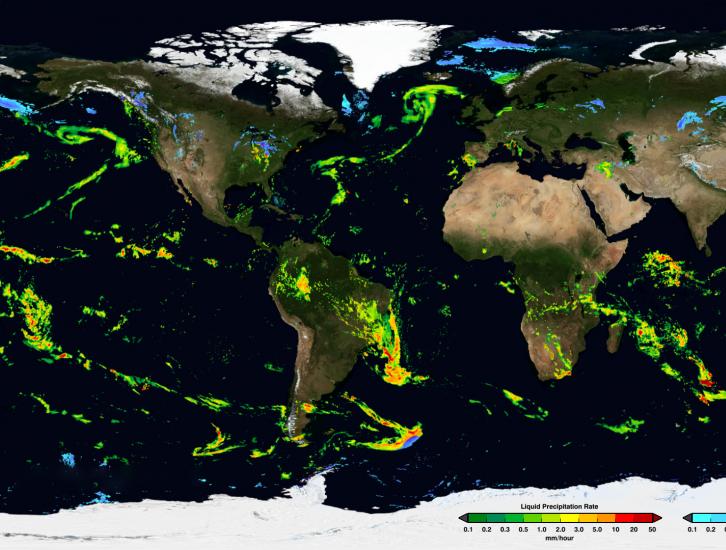There are several sources for downloading and viewing data which allow you to subset the data to only include specific parameters and/or geographic locations. These include the GES DISC, Giovanni and STORM. In Giovanni you can obtain data for a specific country, U.S. state, or watershed by using the "Show Shapes" option in the "Select Region" pane.

Data
Precipitation data from the GPM and TRMM missions are made available free to the public in a variety of formats from several sources at NASA Goddard Space Flight Center. This section outlines the different types of data available, the levels of processing, the sources to download the data, and some helpful tips for utilizing precipitation data in your research.
Beginner Resources
Training
Tutorials
Data Visualization
Data FAQ
Learn about IMERG
The TRMM satellilte has been decommissioned and stopped collecting data in April 2015. The transition from the Tropical Rainfall Measuring Mission (TRMM) data products to the Global Precipitation Measurement (GPM) mission products has completed as of August 2019. The GPM IMERG dataset now includes TRMM-era data from June 2000 to the present, and other TRMM-era data has been reprocessed with GPM-era algorithms and is now available on the GPM FTP servers. TMPA data production ended as of December 31st, 2019 and the TRMMOpen FTP server has been shut down. Historical TMPA data is still available to download from the NASA GES DISC at: https://disc.gsfc.nasa.gov/datasets?keywords=TMPA&page=1
Click here for more details on the transition from TMPA to IMERG.
Yes, in line with NASA's general data policy. Please refer to the GPM Data Policy for further details.
Browse our directory of GPM & TRMM data products to locate your desired algorithm, then click on the links in the algorithm description under "Documentation". All documentation is also available at the Precipitation Processing System website.
The resolution of Level 0, 1, and 2 data is determined by the footprint size and observation interval of the sensors involved. Level 3 products are given a grid spacing that is driven by the typical footprint size of the input data sets.
For our popular multi-satellite GPM IMERG data products, the spatial resolution is 0.1° x 0.1° (or roughly 10km x 10km) with a 30 minute temporal resolution.
Visit the directory of GPM & TRMM data products for details on the resolution of each specific products.
For questions about permission for using NASA images and videos, please refer to NASA's official Media Usage Guidelines. For any additional questions please contact bert.ulrich@nasa.gov
There are several sources for downloading and viewing data which allow you to subset the data to only include specific parameters and/or geographic locations. These include the GES DISC, Giovanni and STORM. In Giovanni you can obtain data for a specific country, U.S. state, or watershed by using the "Show Shapes" option in the "Select Region" pane.
GPM data products can be divided into two groups (near real-time and production) depending on how soon they are created after the satellite collects the observations. For applications such as weather, flood, and crop forecasting that need precipitation estimates as soon as possible, near real-time data products are most appropriate. GPM near real-time (GMI & DPR) products are generally available within a few hours of observation. For all other applications, production data products are generally the best data sets to use because additional or improved inputs are used to increase accuracy. These other inputs are only made available several days, or in some cases, several months, after the satellite observations are taken, and the production data sets are computed after all data have arrived, making possible a more careful analysis.
For the GPM IMERG dataset, IMERG Early and Late Runs are the near real-time products, while IMERG Final Run is the research / production product. Click here to learn more about the differences between IMERG Early, Late and Final.

